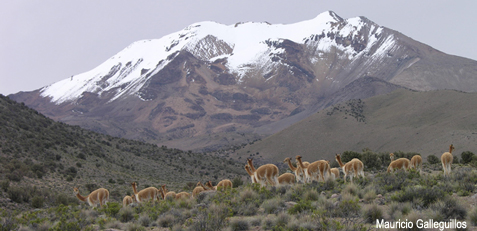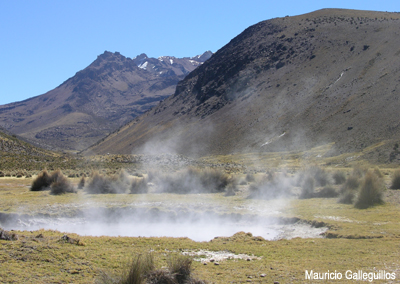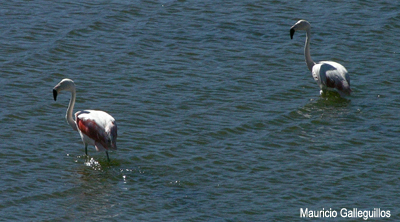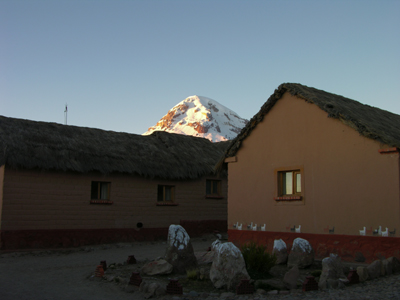 |
 |
|
Sajama National Park
Fortunately, for the visitor, access is relatively straight-forward. The entrance to the park is just off the main paved road between La Paz and the Chilean port city of Arica (Also see Northern Chile). It is straightforward to reach the village of Sajama, the gateway to the national park, by public transportation (taking a La Paz-Arica bus), but with long distances between sites, high altitude and Heading west, at 49 km, there is an interesting road-side archaeological site consisting of burial chulpas. The chulpas combined with some common Altiplano birds, make it a refreshing stop. At 142.5 km some remnant Polylepis can be found on the roadside. Finally, at 169 km, there is a right turn for the village of Sajama and Sajama National Park (the turn is just after the sign-posted 165 kilometer mark). The dirt access road to the park can be muddy in the rainy season and it can take almost a half-hour to arrive at the ranger station (12 km from the turn at the paved road).
Polylepis forest (dominated by Polylepis tarapacana) covers a broad expanse of the lower slopes of Mt. Sajama. One of the best patches in very close to the ranger station at an altitude of 4350 meters. Bird diversity and abundance are low, but some fascinating species can easily be located in the low forest and arid landscape including: Plain-mantled Tit Spinetail, Brown-capped Tit-Spinetail and Rusty-vented Canastero. Olive-backed, Black-hooded, Plumbeous, and Mourning Sierra-Finch have all been recorded. Hummingbirds include Giant Hummingbird and Andean Hillstar. Giant Conebill, though not common, is also present.
When you are in the park, you can ask for the Tomarapi Ecolodge (the picture) in the village of Sajama. This is a comfortable place to stay. We have not been able to get trusted phone numbers for a reservation, but it should be open to arriving visitors. Hopefully it is written up in the latest lonely planet guide for Bolivia. GPS reading at Polylepis forest: S 18 07.891' W 68 56.866' |
|
|
 Sajama National Park in one of the high-altitude jewels in the Bolivian national park system. Created in 1945, Sajama National Park protects a harsh, sometimes bitterly cold, high-altitude environment. With majestic Nevado Sajama, the tallest mountain in Bolivia at 6,542 meters, hot springs bubbling to the surface, snow-capped volcanoes, and abundant wildlife, Sajama has an intriguing mix. In addition to a bird list that surpasses 100 species, mammals such as vicuña and Andean fox can be seen.
Sajama National Park in one of the high-altitude jewels in the Bolivian national park system. Created in 1945, Sajama National Park protects a harsh, sometimes bitterly cold, high-altitude environment. With majestic Nevado Sajama, the tallest mountain in Bolivia at 6,542 meters, hot springs bubbling to the surface, snow-capped volcanoes, and abundant wildlife, Sajama has an intriguing mix. In addition to a bird list that surpasses 100 species, mammals such as vicuña and Andean fox can be seen.  infrequent traffic, a private car is the ideal way to sample the parks treasures. From La Paz, head south on the main highway to Oruro. At 65.5 km after the El Alto tranca, just before the town of Patacamaya, there a well-marked turn to the right (west) for the paved highway to Arica and the Chilean coast. Re-set the odometer to zero at this turn (0.0).
infrequent traffic, a private car is the ideal way to sample the parks treasures. From La Paz, head south on the main highway to Oruro. At 65.5 km after the El Alto tranca, just before the town of Patacamaya, there a well-marked turn to the right (west) for the paved highway to Arica and the Chilean coast. Re-set the odometer to zero at this turn (0.0).  The village of Sajama has the Tomarapi Ecolodge with comfortable housing for a short visit.
The village of Sajama has the Tomarapi Ecolodge with comfortable housing for a short visit.  Logistics: Leaving the Sajama ranger station, continue straight, in 1.6 km, a small sign on the right marks a right turn into a small dirt track for the Polylepis forest. Follow the dirt track, gradually ascending, for 2.2 km to the heart of the Polylepis forest.
Logistics: Leaving the Sajama ranger station, continue straight, in 1.6 km, a small sign on the right marks a right turn into a small dirt track for the Polylepis forest. Follow the dirt track, gradually ascending, for 2.2 km to the heart of the Polylepis forest.